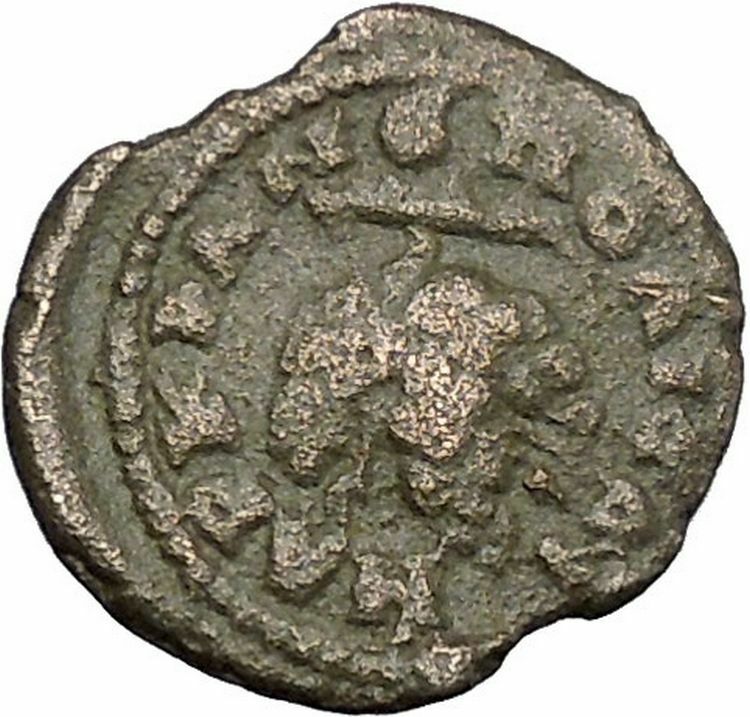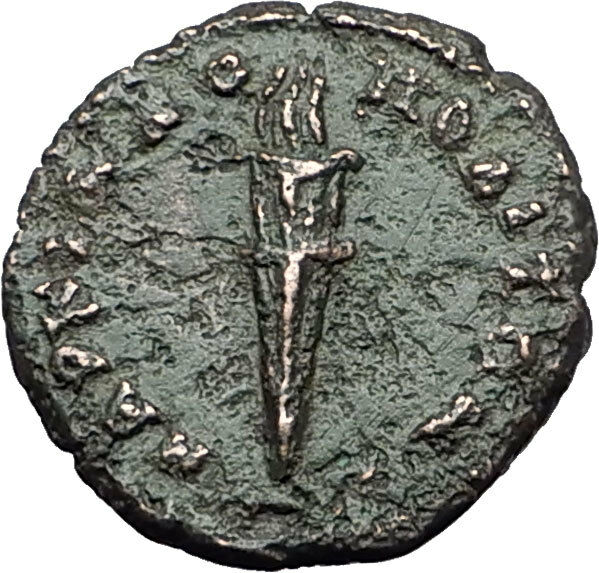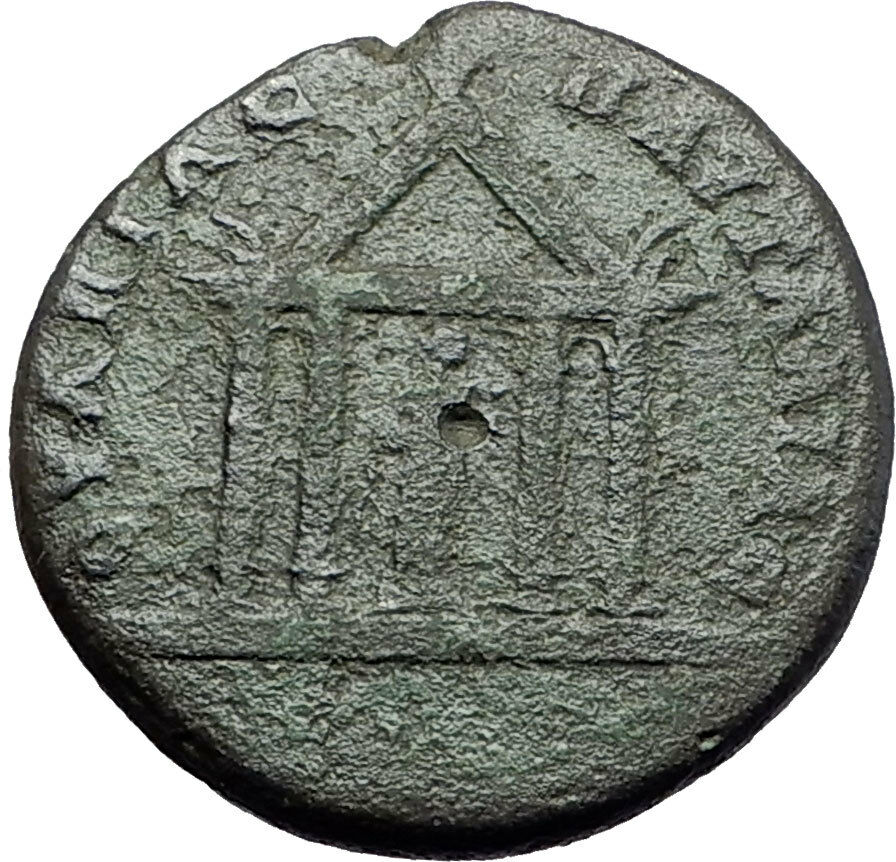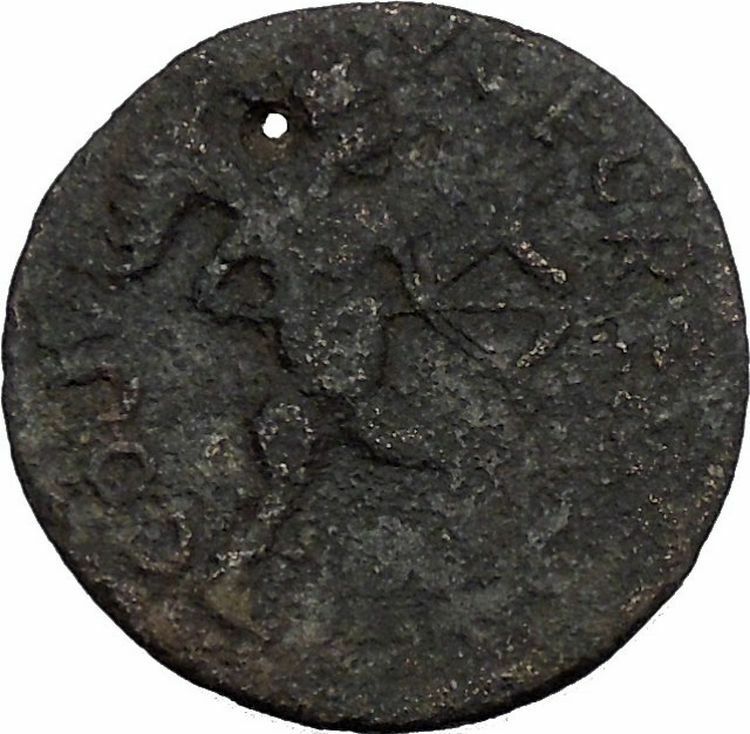|
Severus Alexander –
Roman Emperor: 222-235 A.D.
Bronze 20mm (6.21 grams) of
Amphipolis in
Macedonia
Reference: Varbanov 3299
AVTO K M AVP CЄV AΛЄΞΑΝΔΡΟC, Laureate, draped and
cuirassed bust right
ΑΜΦΙΠΟΛЄΙΤΩΝ,
City-goddess (Tyche) seated left, holding patera; fish below.
You are bidding on the exact item pictured,
provided with a Certificate of Authenticity and Lifetime Guarantee of
Authenticity.
Tyche (Greek for luck; the Roman equivalent was
Fortuna
) was the presiding
tutelary deity
that governed the fortune and
prosperity of a city, its destiny. Increasingly during the Hellenistic period,
cities had their own specific iconic version of Tyche, wearing a
mural crown
(a crown like the walls of the
city).

The
Greek historian Polybius
believed that when no cause can be
discovered to events such as floods, droughts, frosts or even in politics, then
the cause of these events may be fairly attributed to Tyche.
Stylianos Spyridakis concisely expressed Tyche’s appeal in a
Hellenistic world of arbitrary violence and unmeaning reverses: “In the
turbulent years of the
Epigoni of Alexander
, an awareness of the
instability of human affairs led people to believe that Tyche, the blind
mistress of Fortune, governed mankind with an inconstancy which explained the
vicissitudes of the time.”
In literature, she might be given various genealogies, as a daughter of
Hermes
and
Aphrodite
, or considered as one of the
Oceanids
, daughters of
Oceanus
and
Tethys
, or of
Zeus. She was connected with
Nemesis
and
Agathos Daimon
(“good spirit”).
She was uniquely venerated at
Itanos
in Crete, as Tyche Protogeneia,
linked with the Athenian
Protogeneia
(“firstborn”), daughter of
Erechtheus
, whose self-sacrifice saved the
city.
She had temples at
Caesarea Maritima
,
Antioch
,
Alexandria
and
Constantinople
. In
Alexandria
the Tychaeon, the temple of
Tyche, was described by
Libanius
as one of the most magnificent of the
entire Hellenistic world.
Tyche appears on many
coins
of the Hellenistic period in the three
centuries before the Christian era, especially from cities in the Aegean.
Unpredictable turns of fortune drive the complicated plotlines of
Hellenistic romances
, such as
Leucippe and Clitophon
or
Daphnis and Chloe
. She experienced a
resurgence in another era of uneasy change, the final days of publicly
sanctioned
Paganism
, between the late-fourth-century
emperors
Julian
and
Theodosius I
who definitively closed the
temples. The effectiveness of her capricious power even achieved respectability
in philosophical circles during that generation, though among poets it was a
commonplace to revile her for a fickle harlot.
In medieval art
, she was depicted as carrying a
cornucopia
, an
emblematic
ship’s rudder, and the
wheel of fortune
, or she may stand on the
wheel, presiding over the entire circle of fate.
The constellation of
Virgo
is sometimes identified as the heavenly
figure of Tyche, as well as other goddesses such as
Demeter
and
Astraea
.
Amphipolis was an
ancient
Greek
city
in the region once inhabited by the
Edoni
people in the present-day
periphery
of
Central Macedonia
. It was built on a raised
plateau overlooking the east bank of the
river
Strymon
where it emerged from Lake Cercinitis,
about 3 m. from the
Aegean Sea
. Founded in 437 BC, the city was
finally abandoned in the 8th century AD. The present municipality Amfipoli,
named after the ancient city, occupies the site. Currently, it is a municipality
in the
Serres Prefecture
,
Central Macedonia
with a population of 3,623
(2001 census).
Origins
Archaeology
has uncovered remains at the site
dating to approximately 3000 BC. Due to the strategic location of the site it
was fortified from very early.
Xerxes I
of Persia
passed during his invasion of Greece
of 480 BC and buried alive nine young men and nine maidens as a sacrifice to the
river god. Near the later site of Amphipolis
Alexander I
of Macedon
defeated the remains of Xerxes’ army
in 479 BC.
Throughout the 5th century BC,
Athens
sought to consolidate its control over
Thrace, which was strategically important because of its primary materials (the
gold and silver of the
Pangaion hills
and the dense forests essential
for naval construction), and the sea routes vital for Athens’ supply of grain
from Scythia
. After a first unsuccessful attempt at
colonisation in 497 BC by the
Miletian
Tyrant
Histiaeus
, the Athenians founded a first colony
at Ennea-Hodoi (‘Nine Ways’) in 465, but these first ten thousand colonists were
massacred by the
Thracians
. A second attempt took place in 437
BC on the same site under the guidance of
Hagnon
, son of
Nicias
.
The new settlement took the name of Amphipolis (literally, “around the
city”), a name which is the subject of much debates about
lexicography
.
Thucydides
claims the name comes from the fact
that the Strymon flows “around the city” on two sides; however a note in the
Suda (also given in the lexicon of
Photius
) offers a different explanation
apparently given by
Marsyas
, son of
Periander
: that a large proportion of the
population lived “around the city”. However, a more probable explanation is the
one given by
Julius Pollux
: that the name indicates the
vicinity of an isthmus
. Furthermore, the
Etymologicum Genuinum
gives the following
definition: a city of the Athenians or of Thrace, which was once called Nine
Routes, (so named) because it is encircled and surrounded by the Strymon river.
This description corresponds to the actual site of the city (see adjacent map),
and to the description of Thucydides.
Amphipolis subsequently became the main power base of the Athenians in Thrace
and, consequently, a target of choice for their
Spartans
adversaries. The Athenian population
remained very much in the minority within the city. An Athenian rescue
expedition led by strategist (and later historian) Thucydides had to settle for
securing Eion
and could not retake Amphipolis, a failure
for which Thucydides was sentenced to exile. A new Athenian force under the
command of Cleon
failed once more in 422 BC during a
battle
at which both
Cleon
and
Brasidas
lost their lives. Brasidas survived
long enough to hear of the defeat of the Athenians and was buried at Amphipolis
with impressive pomp. From then on he was regarded as the founder of the city
and honoured with yearly games and sacrifices. The city itself kept its
independence until the reign of the king
Philip II
despite several other Athenian
attacks, notably because of the government of
Callistratus
of Aphidnae
.
Conquest
by the Romans
In 357 BC, Philip removed the block which Amphipolis presented on the road to
Macedonian control over Thrace by conquering the town, which Athens had tried in
vain to recover during the previous years. According the historian
Theopompus
, this conquest came to be the object
of a secret accord between
Athens
and Philip II, who would return the city
in exchange for the fortified town of
Pydna
, but the Macedonian king betrayed the
accord, refusing to cede Amphipolis and laying siege to Pydna.
After the conquest by Philip II, the city was not immediately incorporated
into the kingdom, and for some time preserved its institutions and a certain
degree of autonomy. The border of Macedonia was not moved further east; however,
Philip sent a number of Macedonians governors to Amphipolis, and in many
respects the city was effectively ‘Macedonianized’. Nomenclature, the calendar
and the currency (the
gold stater
, installed by Philip to capitalise
on the gold reserves of the Pangaion hills, replaced the Amphipolitan
drachma
) were all replaced by Macedonian
equivalents. In the reign of
Alexander
, Amphipolis was an important naval
base, and the birthplace of three of the most famous Macedonian
Admirals
:
Nearchus
, Androsthenes[6]
and
Laomedon
whose burial place is most likely
marked by the famous lion of Amphipolis.
Amphipolis became one of the main stops on the Macedonian royal road (as
testified by a border stone found between
Philippos
and Amphipolis giving the distance to
the latter), and later on the ‘Via
Egnatia’, the principal
Roman Road
which crossed the southern Balkans.
Apart from the ramparts of the low town (see photograph), the gymnasium and a
set well-preserved frescoes from a wealthy villa are the only artifacts from
this period that remain visible. Though little is known of the layout of the
town, modern knowledge of its institutions is in considerably better shape
thanks to a rich epigraphic documentation, including a military ordinance of
Philip V
and an
ephebarchic
law from the gymnasium. After the
final victory of
Rome
over Macedonia in a
battle
in 168 BC, Amphipolis became the capital
one of the four mini-republics, or ‘merides’, which were created by the Romans
out of the kingdom of the
Antigonids
which
succeeded
Alexander’s Empire in Macedon. These
‘merides’ were gradually incorporated into the Roman client state, and later
province, of Thracia
.
Revival
in Late Antiquity
During the period of
Late Antiquity
, Amphipolis benefited from the
increasing economic prosperity of Macedonia, as is evidenced by the large number
of Christian Churches
that were built.
Significantly however, these churches were built within a restricted area of the
town, sheltered by the walls of the
acropolis
. This has been taken as evidence that
the large fortified perimeter of the ancient town was no longer defendable, and
that the population of the city had considerably diminished.
Nevertheless, the number, size and quality of the churches constructed
between the fifth and sixth centuries are impressive. Four
basilicas
adorned with rich
mosaic
floors and elaborate architectural
sculptures (such as the ram-headed
column
capitals – see picture) have been
excavated, as well as a church with a hexagonal central plan which evokes that
of the
basilica
of
St. Vitalis
in
Ravenna
. It is difficult to find reasons for
such municipal extravagance in such a small town. One possible explanation
provided by the historian
André Boulanger
is that an increasing
‘willingness’ on the part of the wealthy upper classes in the late Roman period
to spend money on local
gentrification
projects (which he terms ‘’évergétisme’’,
from the Greek verb εύεργετέω,(meaning ‘I do good’) was exploited by the local
church to its advantage, which led to a mass gentrification of the urban centre
and of the agricultural riches of the city’s territory. Amphipolis was also a
diocese
under the
suffragan
of
Thessaloniki
– the Bishop of Amphipolis is
first mentioned in 533 AD.
From
the reduction of the urban area to the disappearance of the city
The
Slavic invasions
of the late 6th century
gradually encroached on the back-country Amphipolitan lifestyle and led to the
decline of the town, during which period its inhabitants retreated to the area
around the acropolis. The ramparts were maintained to a certain extent, thanks
to materials plundered from the monuments of the lower city, and the large
unused cisterns of the upper city were occupied by small houses and the
workshops of artisans. Around the middle of the 7th century AD, a further
reduction of the inhabited area of the city was followed by an increase in the
fortification of the town, with the construction of a new rampart with
pentagonal towers cutting through the middle of the remaining monuments. The
acropolis, the Roman baths
, and especially the Episcopal
basilica were crossed by this wall.
The city was probably abandoned in the eighth century, as the last bishop was
attested in 787. Its inhabitants probably moved to the neighbouring site of
ancient Eion
, port of Amphipolis, which had been
rebuilt and refortified in the
Byzantine period
under the name “Chrysopolis”.
This small port continued to enjoy some prosperity, before being abandoned
during the
Ottoman period
. The last recorded sign of
activity in the region of Amphipolis was the construction of a fortified tower
to the north in 1367 by
Grand Primicier
Jean and the
Stratopedarque
Alexis to protect the land that
they had given to the monastery of Pantokrator on
Mount Athos
.
Archaeology
The site was rediscovered and described by many travellers and archaeologists
during the 19th century, including E. Cousinéry (1831) (engraver), L. Heuzey
(1861), and P. Perdrizet (1894–1899). In 1934, M. Feyel, of the
École française d’Athènes
, led an
epigraphical mission
to the site and uncovered
the remains of a funeral lion (a reconstruction was given in the, a publication
of the EfA which is available on line). However, excavations did not truly begin
until after the Second World War. The
Greek Archaeological Society
under D. Lazaridis
excavated in 1972 and 1985, uncovering a necropolis, the rampart of the old town
(see photograph), the basilicas, and the acropolis.
Amphipolitans
-
Demetrius of Amphipolis
, student of Plato’s
- Zoilus
(400 BC-320 BC), grammarian, cynic
philosopher
-
Pamphilus (painter)
, head of
Sicyonian
school and teacher of
Apelles
- Aetion
, sculptor
-
Philippus of Amphipolis
, historian
- Nearchus
, admiral
- Erigyius
, general
- Damasias
[disambiguation
needed] of Amphipolis 320 BC
Stadion
Olympics
-
Hermagoras of Amphipolis
(c. 225 BC), stoic
philosopher ,follower of
Persaeus
- Xena
, the Warrior Princess of Amphipolis.
Marcus
Aurelius Severus Alexander (October 1, 208–March 18, 235 AD), commonly
called Alexander Severus, was the last
Roman emperor
(11 March 222–235) of the
Severan dynasty
. Alexander Severus succeeded his cousin,
Elagabalus
upon the latter’s assassination in 222 AD, and was ultimately assassinated
himself, marking the
epoch event
for the
Crisis of the Third Century
—nearly fifty years of disorder, Roman civil
wars, economic chaos, regional rebellions, and external threats that brought the
Empire to near-collapse.
Alexander Severus was the
heir
apparent
to his cousin, the eighteen-year-old Emperor who had been murdered
along with his mother by his own guards—and as a mark of contempt, had their
remains cast into the
Tiber river
. He and his cousin were both grandsons of the influential and
powerful Julia Maesa
, who had arranged for Elagabalus’ acclamation as Emperor by the
famed
Third Gallic Legion
.
A rumor of Alexander’s death circulated, triggering the assassination of
Elagabalus.
Alexander’s reign was marked by troubles. In military conflict against the
rising
Sassanid Empire
, there are mixed accounts, though the Sassanid threat was
checked. However, when campaigning against
Germanic tribes
of
Germania
,
Alexander Severus apparently alienated his legions by trying diplomacy and
bribery, and they assassinated him.
Life
Alexander was born with the name Marcus Julius Gessius Bassianus Alexianus.
Alexander’s father,
Marcus Julius Gessius Marcianus
was a Syrian
Promagistrate
. His mother
Julia Avita Mamaea
was the second daughter of
Julia
Maesa
and Syrian noble
Julius Avitus
and maternal aunt of Emperor
Elagabalus
.
He had an elder sister called Theoclia and little is known about her.
Alexander’s maternal great-aunt was empress
Julia
Domna
(also Maesa’s younger sister) and his great-uncle in marriage was
emperor Lucius
Septimius Severus
. Emperors
Caracalla
and
Publius Septimius Geta
, were his mother’s maternal cousins. In 221,
Alexander’s grandmother, Maesa, persuaded the emperor to adopt his cousin as
successor and make him
Caesar
and Bassianus changed his name to Alexander. In the following
year, on March 11, Elagabalus was murdered, and Alexander was proclaimed emperor
by the
Praetorians
and accepted by the Senate.
When Alexander became emperor, he was young, amiable, well-meaning, and
entirely under the dominion of his mother. Julia Mamaea was a woman of many
virtues, and she surrounded the young emperor with wise counsellors. She watched
over the development of her son’s character and improved the tone of the
administration. On the other hand, she was inordinately jealous. She also
alienated the army by extreme parsimony, and neither she nor her son were strong
enough to impose military discipline. Mutinies became frequent in all parts of
the empire; to one of them the life of the jurist and praetorian praefect
Ulpian
was
sacrificed; another compelled the retirement of
Cassius
Dio
from his command.
On the whole, however, the reign of Alexander was prosperous until the rise,
in the east, of the
Sassanids
. Of the war that followed there are various accounts. (Mommsen
leans to that which is least favourable to the Romans). According to Alexander’s
own dispatch to the senate, he gained great victories. At all events, though the
Sassanids were checked for the time, the conduct of the Roman army showed an
extraordinary lack of discipline. The emperor returned to
Rome and celebrated
a triumph in 233.
The following year he was called to face German invaders in
Gaul, who had
breached the Rhine frontier in several places, destroying forts and over-running
the countryside. Alexander mustered his forces, bringing legions from the
eastern provinces, and crossed the Rhine into Germany on a pontoon bridge.
Initially he attempted to buy the German tribes off, so as to gain time. Whether
this was a wise policy or not, it caused the Roman legionaries to look down on
their emperor as one who was prepared to commit unsoldierly conduct.
Herodian
says “in their opinion Alexander showed no honourable intention to pursue the
war and preferred a life of ease, when he should have marched out to punish the
Germans for their previous insolence”. These circumstances drove the army to
look for a new leader. They chose
Gaius Iulius Verus Maximinus
, a Thracian soldier who had worked his way up
through the ranks.
Following the nomination of Maximinus as emperor, Alexander was slain (on
either March 18 or March 19, 235), together with his mother, in a mutiny of the
Primigenia Legio XXII
. These assassinations secured the throne for
Maximinus.
The death of Alexander is considered as the end of the Principate
system established by
Augustus
.
Although the Principate continued in theory until the reign of
Diocletian
,
Alexander Severus’ death signalled the beginning of the chaotic period known as
the
Crisis of the Third Century
which weakened the empire considerably.
Legacy
Alexander was the last of the Syrian emperors. Under the influence of his
mother, he did much to improve the morals and condition of the people. His
advisers were men like the famous jurist Ulpian, the historian Cassius Dio and a
select board of sixteen senators; a municipal council of fourteen assisted the
urban praefect in administering the affairs of the fourteen districts of Rome.
The luxury and extravagance that had formerly been so prevalent at the court
were put down; the standard of the coinage was raised; taxes were lightened;
literature, art and science were encouraged; the lot of the soldiers was
improved; and, for the convenience of the people, loan offices were instituted
for lending money at a moderate rate of interest.
In religious matters Alexander preserved an open mind. It is said that he was
desirous of erecting a temple to the
founder of
Christianity
, but was dissuaded by the pagan priests.
Marriage
Alexander was married three times. His most famous wife was
Sallustia Orbiana
,
Augusta
, whom he married in 225. He divorced and exiled her in 227,
after her father,
Seius Sallustius
, was executed for attempting to assassinate the emperor.
Another wife was Sulpicia Memmia. Her father was a man of consular rank; her
grandfather’s name was Catulus.
|










